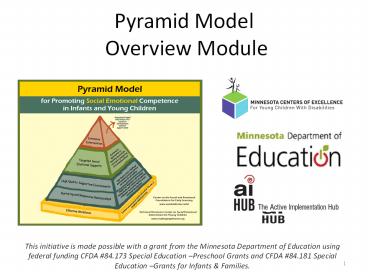Pyramid%20Model%20%20Overview%20Module - PowerPoint PPT Presentation
Title:
Pyramid%20Model%20%20Overview%20Module
Description:
Pyramid Model Overview Module This initiative is made possible with a grant from the Minnesota Department of Education using federal funding CFDA #84.173 Special ... – PowerPoint PPT presentation
Number of Views:141
Avg rating:3.0/5.0
Title: Pyramid%20Model%20%20Overview%20Module
1
Pyramid Model Overview Module
This initiative is made possible with a grant
from the Minnesota Department of Education using
federal funding CFDA 84.173 Special Education
Preschool Grants and CFDA 84.181 Special
Education Grants for Infants Families.
2
Is The Pyramid Model Right for Your Program?
- What is the Pyramid Model?
- Why Focus on Social Emotional Development?
- How Does the Pyramid Model Work?
- Stages of Implementation
- Benchmarks of Quality
- Data Collection
- Implementation Team
- Internal Coaching
- How Will We Know if We are Ready?
- What are the Benefits to Our Program?
- What are the Next Steps?
3
What is the Pyramid Model?
Tertiary Intervention Few Children
Secondary Prevention Some Children
Universal Promotion All Children
4
Foundation Effective Workforce
- The foundation for all practices in the Pyramid
Model are the systems and policies necessary to
ensure a workforce that is able to adopt and
sustain the evidence-based practices.
5
Nurturing Responsive Caregiving Relationships
and High Quality Supportive Environments TIER 1
- Supportive and responsive relationships among
adults and children is an essential component to
promote healthy social emotional development. - High quality early childhood environments promote
positive outcomes for ALL children.
6
Targeted Social Emotional Supports TIER 2
- Provides explicit instruction around social
emotional skills. - Addresses self regulation, expressing and
understanding emotions, and developing social
relationships. - Some children need systematic and focused
instruction to learn discrete social emotional
skills.
7
Individualized Intensive InterventionsTIER 3
- Individualized Intervention
- When children have ongoing challenging behavior,
comprehensive interventions are developed to
resolve problem behaviors and support the
development of new skills. - ? Family-Centered Intervention
- ? Assessment Based
- ? Focus on Skill Building
8
Why focus on social-emotional development?
- Incidence Prevalence
- Statistics
- Link to academic achievement
9
Why this Deserves Attention
- A childs delayed development can lead to more
severe problem behavior. - Social development and the ability to be engaged
is essential for school readiness. - Children with severe behavior problems are deeply
at risk for social exclusion and academic
failure. - The Pyramid Model has a particular focus on
supporting the social development and
relationships of young children with or at risk
for delays or disabilities.
10
How does Program Wide Adoption of the Pyramid
Model Work?
- Process for implementing the Pyramid Model to
fidelity
- Content Strategies
11
Critical Elements of Implementation Benchmarks
Of Quality
- Formally completed at least two times per year,
but referred to on an ongoing basis. - Guides Implementation Team and assesses progress
towards Full Implementation to fidelity. - Used to guide Implementation Teams Action Plan.
- Used to provide feedback to site.
12
What Data Will be Collected Used?
- Ages Stages Questionnaire/Social Emotional
(ASQ-SE) - Teaching Pyramid Observation Tool (TPOT)/ 3-5
AND The Pyramid Infant Toddler Observation Scale
(TPITOS)/0-3 - Monthly Program Tracking Action Form (MPTA)
- Behavior Incident Report (BIRs)
- Benchmarks of Quality (BOQ)
- Optional Performance Review Measure
13
Implementation Team Membership
- Administrator from ECSE Inclusion Partner
- Behavior Specialist
- Data Manager
- Internal Coach (1-2)
- Teacher Representative (1-2)
- Professional Development Facilitator (PDF)
Leadership is ultimately about creating a way for
people to contribute to making something
extraordinary happen. (Alan Keith)
14
What is Coaching in Pyramid Model Implementation?
- An ongoing, outcome focused approach to improving
intervention practices by providing opportunities
to observe practices, implement with support and
eventually implement independently. Coaching
refers more specifically to on-site and in-vivo
guidance provided by a consulting professional in
order to help a practitioner (parent, teacher,
child care professional) learn to implement an
intervention procedure with fidelity.
15
(No Transcript)
16
What are the Expected Benefits?
- Staff view themselves as having the skills to
better support children in classrooms. - Staff look to each other as sources of additional
information and support. - Staff can demonstrate the fundamental elements in
their classrooms. - A culture of support is created throughout the
program. - Staff become intentional and purposeful in
interactions with children in order to build on
their strengths.
17
What are the Expected Benefits?
- Staff turn over is reduced staff satisfaction is
increased. - Staff ask for fewer suggestions from mental
health professionals. - The number of children receiving individual
counseling from psychologists decreased. - The number of children identified as having
challenging behavior and referred for mental
health services decreased. - Program spends less time and resources on
intervention level and more on prevention level
of the Pyramid.
18
For More Information.
- Technical Assistance Center on Social Emotional
Intervention for Young Children (TACSEI) - www.challengingbehavior.org
- Pyramid Model Overview
- http//challengingbehavior.fmhi.usf.edu/explore/ca
mtasia/pyramid_overview/pyramid_overview_captions.
html - Center on Social Emotional Foundations for Early
Learning (CSEFEL) - www.vanderbilt.edu./csefel/
- 11 minute Overview of the Pyramid Model on
YouTube - https//www.youtube.com/watch?vxYYOUtMHHJst30
- 28 minute video on importance of Social Emotional
Development - http//csefel.vanderbilt.edu/resources/social_emot
ional_competence.html
19
What are the Next Steps?
This initiative is made possible with a grant
from the Minnesota Department of Education using
federal funding CFDA 84.173 Special Education
Preschool Grants and CFDA 84.181 Special
Education Grants for Infants Families.































